Nature Conservation 2024 — 30. 5. 2024 — International Nature Conservation — Print article in pdf
Nature Conservation in Uzbekistan
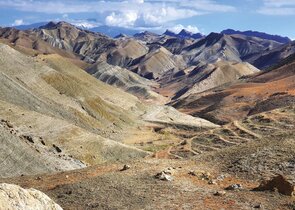
Uzbekistan, a pearl of the Silk Road, is an area of extraordinarily accumulation of well-preserved medieval Islam towns and monuments remembering the then extensive empire controlling considerable parts of Central and Southwest Asia. The current Republic of Uzbekistan boasts from the natural science point of view valuable areas of international importance. The country has legislatively developed nature conservation system aiming particularly at protecting the human environment; nevertheless, it can only in a limited way reduce natural wealth destruction which has been threatened by demands from the rapidly developing most populous Central Asian republics. Therefore, we can visit a UNESCO World Heritage Site as well as to watch one of the world’s biggest environmental disasters ever there.
Uzbekistan is located between two big Central Asian rivers, Amu Darya and Syr Darya, covering 447,400 km2 where cold arid continental climate prevails. The position at the crossroad of some Central Asian biogeographical regions determines rich biological diversity there. The significant Pamir-Alay and Western Tien-Shan mountains neighbouring Kazakhstan, Kyrgyzstan and Tajikistan create the Mountains of Central Asia global biodiversity hotspot. Alpine meadows situated usually above 2,700 meters a.s.l. have been still maintaining its diversity and heterogeneity despite grazing pressure being higher there than in the neighbouring Republic of Kyrgyzstan (Pešout 2017). Adyrs, ecosystems of submontane plains and low hills on foothills of high mountains are even more threatened by agriculture. The Fergana Valley, located just among the eastern mountains, is almost entirely managed and it is a place of occasional conflicts with neighbouring Kyrgyzstan and Tajikistan. Among specific Central Asian ecosystems of lower altitudes tugay should be mentioned. It is a form of riparian forest, woodland or shrubland associated with fluvial and floodplain areas in arid climates. In Uzbekistan, they have been preserved close to rivers but on small plots only. Because occurrence of the above habitat is linear, it provides wild animals with a significant migration/dispersal corridor, but it has been more and more fragmented by built-up areas. It retreats also in floodplains of rivers that due to large water for irrigation and climate change impacts have been more and more often becoming dried-up year-round. For the same reason, majority of wetlands have been facing the direct loss there. Of course, the most alarming momentum of the giant dimension is the disappearing Aral Sea wetland ecosystem with the then unique biological diversity. The at first glance hostile Kyzylkum Desert located in a central part of Uzbekistan and the Ustyurt Plateau in the west of the country harbour many sites characterized by rich biocenosis with high level of endemism.

The most strictly protected areas except of small-size Nature Reserves on the territory of the Republic of Uzbekistan as of 1 January 2023. The colours on the map correspond to the colours and numbers to the numbers in round bracket in Table 1. © Pavel Pešout, graphical design © Jan Vrba.
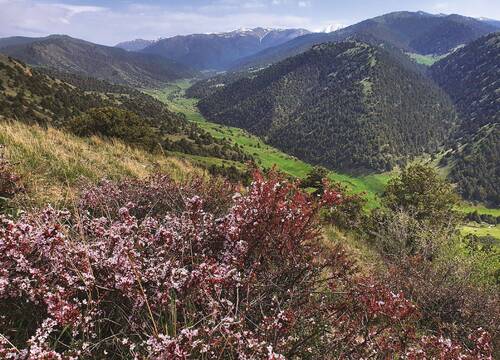
Forests cover only 7 % of Uzbekistan’s territory, they consist of a huge range of habitats – from walnut tree forests in the Nurata Mountains. or juniper sparse forests in the Chatkal Mountains. to mountain forests in the Pamir-Alay Mountains. A photo from the Zaamin Strict Nature Reserve. © Pavel Pešout
Uzbekistan’s population consists of almost 35 million: half of them live in the country and are employed in agriculture. Together with climate change, just agriculture related to irrigation has been causing continuing desertification. In addition to intensive plant production in lowlands and animal husbandry/pastural farming in montane and submontane areas, mineral raw material extraction and mining, increasing landscape fragmentation and constantly accelerating development in power industry and industrial production negatively impact nature and the landscape there.
Table 1 Overview of some protected areas in Uzbekistan as of 1 January 2023
State Nature Conservancy structure
Nature conservation in Uzbekistan is legislatively anchored and has at disposal many tools that have not been sufficiently implemented yet. The main legislation, the Nature Conservation Act adopted in 1992 laid the legal, economic and institutional foundations for nature conservational across the whole country. A series of laws was later adopted: they follow up various partial issues, e.g. rational/wise use of natural resources (1992), water and its management (1993), flora protection and use (1997), forests (1993), protected nature areas (2004), ecological/environmental inspection and checking (2013), wild animal protection and use (2016), etc. (Kuchkarov 2018).
The nature conservation law warrants to citizens right to stay in the preserved natural environment, rationally use of natural resources, receive information on the state of nature and to establish civil society/non-profit nature conservation organisations. It also sets a voluntary insurance for damage caused to nature and natural resources.
The highest nature conservation authority is the Cabinet of Ministers of the Republic of Uzbekistan (hereinafter the Government) declaring important protected areas, setting charges, establishing communication, education and public awareness in nature conservation and environmental protection, managing and supervising international relations, etc. Local state/public administration authorities deal with permitting and imposing of a charge on water resources extraction, land-use/territorial planning, establishing protected areas of sub-national importance, etc. The executive body and state/public administration authority in nature conservation is the State Committee of the Republic of Uzbekistan on Ecology and Environmental Protection (hereinafter the State Committee), which provides implementation state policy in environmental security, environmental protection and in use and reproduction of natural resources1. At present, the Committee also is the central enforcement state/public administration authority for nature conservation and all components of the environment: it can individually take decision and it prepares background documents for other decision-making. The Committee of the Republic of Karakalpalstan2 for Ecology and Environmental Protection acts separately.
Pursuant to the Nature Conservation Act, the Fund for Ecology, Environmental Protection and Waste Management was established within the scope of authority of the Committee just in 1992: it funds research, environmental protection and communication on, education in and public awareness of the environment (hereinafter the Fund). In addition to the State Budget, the Fund’s main income includes fines for breaking and violating the law, purchases of confiscated things and donations. Within the State Committee, the Inspectorate for Control over Protection and Use of Biodiversity in Protected Natural Areas (the Bioinspectorate) has been acting since 2017.
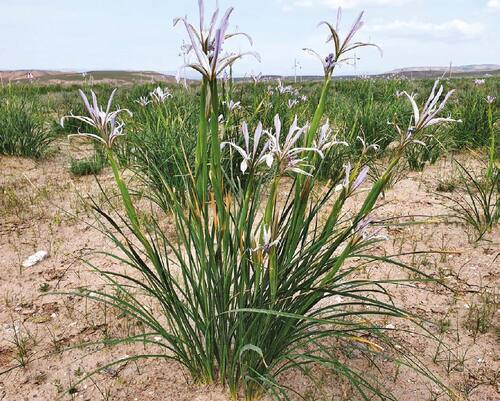
Annually in spring, parts of the Kyzylkum Desert bloom by millions of the Junggar iris (Iris songarica) flowers: the area is a central part of the species’ Central Asian distribution range (Sennikov et al. 2023). © Pavel Pešout

By passing its resolution, the Government can impose an admission fee for Complex Landscape Wildlife Sanctuaries, Natural Parks, National Parks and State Biosphere Reserves. In addition to finances generated from issuing permits on natural resource use and incomes from recreational, tourist and other use of protected areas permitted by the law, admission fees are welcomed income of organisations managing the above protected areas. Picture shows an entrance gate to the Zaamin National Park where admission fee is collected both for persons and cars. © Pavel Pešout
Species protection
High species richness or alpha-diversity of Uzbekistan features high number of endemic species or other taxa. Of 5 000 wild plant species having been known from the country, more than 500 are endemic (Tijibaev 2010). Among them, those from the genus Tulipa, Allium, Gagea, Eremurus, Astragallus and Iris should be mentioned. Research on and surveys of invertebrates constantly provide findings of new taxa: up to now, occurrence of 15,000 invertebrate species has been reported from the Republic of Uzbekistan’s territory. The country is inhabited also by 714 vertebrate species, of them 8.5 % are endemics. The reptile species account even for 50 % endemic (anonymous 2001).
Conservation and sustainable use of biological diversity are among the State policy’s priorities. The Government adopted and has been implementing a national programme/strategy and action plan on biodiversity. Uzbekistan’s species protection legislation sets down strict protection of habitats, explicitly prohibits some activities damaging wild plants and animals, assigns protection of wildlife migration routes when locating water buildings, traffic routes and power lines as well as monitoring and record keeping obligation, provides for action plans/recovery programmes for threatened species and enacts national Red Lists of Threatened Species elaboration.
Action plans/recovery programmes are set down and implemented for the selected species: they also deal with measures taken both in the wild and ex situ. Wild plant species enjoying active management include the endemic shrub Otostegia bucharica, a Tertiary relic endemic that was translocated during building the Tashguzar-Baysub railroad (Tojibaev 2019) or the rootthug Thesium minkwitzianum, which currently is known only from three sites in the Tien-Shan Mountains (Sadikov et al. 1984): for the latter taxon, a scientific and research recovery programme was elaborated that consists of, inter alia, establishing a seed vault, recovery sowing in situ as well as planting individuals in the Tashkent Botanical Garden (Tojibaeev 2010).
Among iconic flagship wild animal species an action plan/recovery programme has been adopted and implemented, the Saiga antelope (Saiga tatarica) should be mentioned. It is estimated that global population of the remarkable ungulate declined by 90% during the past quarter of a century. The main drivers of the dramatic decline include poaching of males for horns used in Traditional Chinese Medicine (TCM), natural habitat fragmentation, degradation, destruction and loss as well as devastation of migration routes. One of the most numerous populations inhabits the Ustyurt Plateau near the Kazakhstan border. Moreover, only in Uzbekistan, the Saiga antelope numbers decreased from 80,000 in 1990 to a few dozens of individuals only in the course of thirty years. Due to intensive protection, conservation and management, the unfavourable trend was reversed and since that time the numbers of the antelope have been increasing up to present 200 animals (Milner-Gulland et al. 2020). The MacQueen's bustard (Chlamydotis macqueenii)3 is also provided with an action plan/recovery programme. In 2006, the State Nature Conservancy in cooperation with the Emirates Bird Breeding Centre for Conservation built a breeding facility near Bukhara that has reared and released into the Kyzylkum Desert 18,000 bustards since 2010 (Dolman et al. 2021). The State Nature Conservancy also runs the Jeyran Ecological Centre aiming at breeding naturally rare or threatened wild animal species, e.g. the Severtzov’s argali (Ovis severtzovi) or the Bactrian deer (Cervus elaphus bactrianus) protected in the Amu Darya or the Zarafshan protected areas (Comelis et al. 2021)4. Nevertheless, material and breeding level of the exhibition part in the Centre is at present literally pitiful. Maybe more satisfactory outputs are displayed by the Jeyran Ecological Centre in conservation breeding e.g. of the Turkmenian khulan (Equus hemionus) (Balhoul 2001).
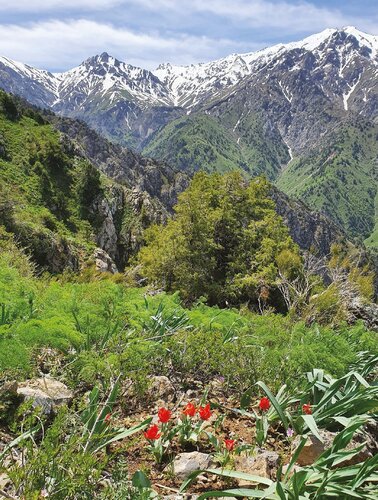
Great appreciation of Uzbekistan’s nature is inscription of most of the Ugam-Chatkal National Park (357.24 km2) on the UNESCO World Heritage List under the name Western Tien-Shan in 2014. © Pavel Pešout
Protected area network
The first protected areas declared in Uzbekistan are the Zaamin Strict State Reserve (1926) and the Chatkal Mountain Forest Reserve established by the Council of Ministries of the Uzbek Soviet Socialist Republic in 1947. At present the total area of reserves, parks and monuments is approx. 50,000 km2, i.e. 11 % of the republic’s territory5 (see Table 1).
The protected area network is quite complicated, almost labyrinthine which results from the nature conservation paradigm aiming at protecting the environment for humans. Basically, it is a network from the Soviet era completed by protected area international categories (unfortunately without effort to remove duplicities). The Uzbek act of 2004 on protected natural areas distinguish according to purpose twelve protected area categories, of them some are divided into two or more types:
- (Strict) State Reserves (zapovedniks) are extensive strictly protected areas dedicated to spontaneous development where, except for the state/public administration and implementation of obligatory monitoring and research, entry is prohibited;
- Complex Landscape Wildlife Sanctuaries are extensive areas of valuable nature damaging of which is prohibited except for implementation of monitoring, grazing and hay-making and collecting wild plants and fruits by local people living in buffer zones;
- Natural Parks are extensive areas with specific scientific, cultural or aesthetic values. According to their importance, they are divided into National Natural Parks and Local Natural Parks. In Natural Parks, zones of conservation, recreational use, economic use and other use are delineated. Within the whole park’s territory, damaging nature is prohibited, e.g. forest clear-cutting management, hydrological regime change, changes causing soil erosion, landfilling, constructing engineering structures, etc. In part of the Natural Park, local people can permanently live and farm or in other ways manage the landscape.
- National Nature Monuments are generally smaller sites of national importance with unique scientifically, culturally or aesthetically valuable natural entities. They are divided in the following types: hydrological, botanical, geomorphological, paleontological, geological and mineralogical. National Nature Monuments often include also sacral sites, e.g. springs: therefore, they can be leased to religious organisations but only on the condition that they shall implement the right management there.
- Nature Reserves (zakazniks) are established for protection of the individual natural phenomena, usually being of smaller size. They are of either national or local importance and they are divided into similar types as National Nature Monuments. In Nature Reserves, all activities that would damage the subjects of protection are prohibited.
- Natural Nurseries are natural areas for implementing wild animal recovery breeding or threatened plant species planting: they are either public or private.
- Protected Landscapes are declared to protect larger territorial units important as ecosystem service providers. They include recreational natural areas, areas with healing or healthy effects, mineral springs, healing mud deposits, favourable climatic or other conditions, etc. Within their whole territory, it is prohibited to use pesticides, change hydrological regime, fell woody plants, to excavate or to mine for mineral resources and other activities which would make use of the protected area for recreation and leisure time worse.
- Protected Fish Areas are watercourse stretches or water bodies used for protection, conservation, reproduction or recovery of rare and threatened fishes or other water organisms as well as for fisheries or angling.
- Areas for Natural Resource Management include forests, hunting grounds for wise game use, etc.
- In 2014, a possibility to establish Biosphere Reserves, Transboundary Protected Areas and National Parks was amended to the Act. National Parks are natural areas dedicated for nature protection and conservation and wise use of nature for environmental, recreational, scientific and cultural purposes displaying unique ecological, scientific, cultural and aesthetical values. National Park’s territory is divided into zones with different intensity of protection, conservation and management. These newly set categories often overlap some previous ones.
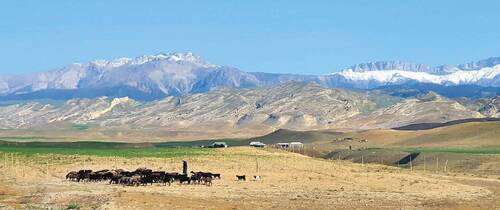
Adyrs, ecosystems of submontane plains and low hills on the foothills of the Pamir-Alay Mts. are damaged by overgrazing. In the background of the picture, Gissar Mountains., having been strictly protected fifty years, can be seen. © Pavel Pešout
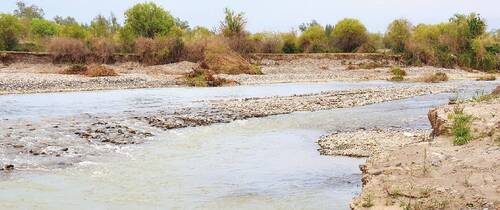
Tugays are among the specific Central Asian ecosystems. These riparian shrublands or forests have been preserved in the vicinity of rivers in Uzbekistan’s arid areas. They are protected e.g. in the Zarafshan Natural Park. © Pavel Pešout
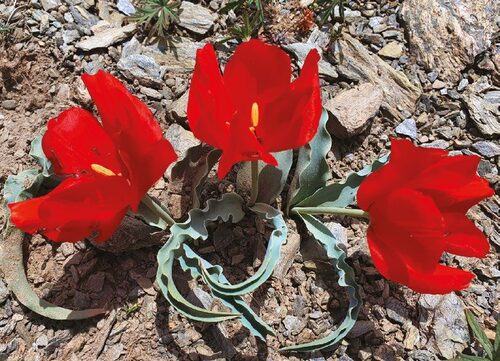
Central Asia is a original distribution range of tulips. We can meet them in all main mountain ranges in Uzbekistan. The photo presents Tulipa korolkowii in the Nuratau Strict State Reserve. © Pavel Pešout
In the framework of international biodiversity conservation, wetlands of international importance (Ramsar Sites) were delineated under the Ramsar Convention. The Uzbekistan Society for the Protection of Birds has identified 48 Important Bird Areas (IBAs) covering of 4.6% of the Uzbekistan’s territory (Avé et al. 2012) and nature reserves in the Tian Shan Mountains have been inscribed on the UNESCO World Heritage List (Anonymous 2014). Within the Convention on Biological Diversity (CBD), the country has developed and approved its National Biodiversity Strategy and Action Plan.
The Act allows establishing private reserves or natural nurseries and they really are declared, e.g. two areas for breeding MacQueen's bustards (see above). Private protected area management is funded by both legal and natural persons.
Although the Government approved measures aiming at higher protected area effectiveness in 20196, and consequently those establishing extensive buffer zones of the selected zapovedniks and Natural Parks (Nabieva & Mamatova 2021), protected area governance has been fragmented in Uzbekistan. Management of nationally important protected areas is carried out by the State Committee and bodies managed by it and by inspectors, other protected areas are managed by local authorities and self-governing bodies, in some case by land owners themselves.
Moreover, protected areas are preferentially owned by the State. Pursuant to the legislation, the State should compensate legal and natural persons for losses caused by introducing territorial protection on their lands. The compensation can be provided also by receiving alternative agricultural/farmland or forest plots. For all lands in protected areas there is land tax exemption, which is not applied for the cases when lands are commercially/economically managed, e.g. farmed. The Act also guarantees free access to protected areas for citizens. Moreover, but the admission into them can be limited or prohibited in justified cases by the state/public administration authorities. Protected areas should be taken into account in land-use/territorial planning, elaborating projects on natural resource exploitation or developing plans on economical use of the affected plots.
The Act established the state register of protected areas where detailed toponymic information, information on values of the specific area and other data are available. The register is managed by the State Committee in co-operation with the Academy of Sciences of Uzbekistan. For protected areas, management plans are developed and approved: they include a set of measures for conservation and use of natural entities there. Content of management plans for protected areas is given by the State Committee, which also check their implementation in practice. Monitoring and research in protected areas are coordinated by the Academy of Sciences of Uzbekistan and are financed from the Fund. In each Strict State Reserve (zapovednik) Scientific Council is established. Results of research are used by the protected area administration free of charge and pursuant to the act scientific files should not been shredded and they have to be maintained for an indeterminate period of time.
Nature conservation and landscape protection is among the Uzbekistan’s priorities which has been evidenced by a recent significant increase in the total protected area coverage and by implementing many threatened species action plans/recovery programmes. The future will show how the still rich biodiversity has been maintained despite continuing desertification and increasing demand of citizens in the rapidly developing Central Asian country. ■
- - - -
Cover photo:
Boysun Mountains in south-eastern Uzbekistan © Pavel Pešout
- - - -
Notes:
- The State Committee was established as early as in 1988 as a response to the Aral Sea drying up and the rapidly deteriorating state of the environment in Uzbekistan.
- The autonomous Republic of Karakalpalstan, covering a territory more than twice larger than the Czech Republic, occupies most of the Uzbekistan’s western part.
- The Resolution of the Cabinet of Ministers of the Republic of Uzbekistan No. 276/2008 On measures for increasing effectiveness in breeding the MacQueen's bustard on the territory of the Republic of Uzbekistan dealing with creating the conditions for breeding rare threatened bird species listed in the Red Data Book and aiming at conservation of their gene pool and ensuring increase in their numbers.
- For recovering the Bukhara deer population, the Memorandum of Understanding concerning Conservation and Restoration of the Bukhara Deer was signed by Uzbekistan. Kazakhstan, Tajikistan and Turkmenistan in 2002. The MoU, Action Plan and other documents are available at https://www.cms.int/bukhara-deer/.
- It really is admirable that the total protected area coverage in Uzbekistan almost doubled in the last five years. The most recent protected areas are the Central Kyzylkum National Natural Park and the Aktau-Tamdy National Park declared pursuant to the Resolution of the President of the Republic of Uzbekistan No. 131.6 of 16 February 2022.
- The Resolution of the Cabinet of Ministers of the Republic of Uzbekistan No. 4247/2019 On measures to improve State/Public Administration in protected natural areas management and governance.


